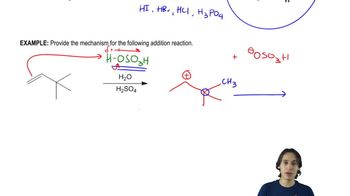Here are the essential concepts you must grasp in order to answer the question correctly.
Acid-Catalyzed Hydration
Acid-catalyzed hydration is a chemical reaction where an alkene or alkyne reacts with water in the presence of an acid catalyst, typically resulting in the formation of an alcohol. In the case of alkynes, this process involves the addition of water across the triple bond, leading to the formation of a carbonyl compound, such as a ketone, after rearrangement and tautomerization.
Recommended video:
Acid-catalyzed hydration mechanism
Alkyne Structure and Reactivity
Alkynes are hydrocarbons that contain at least one carbon-carbon triple bond. The structure of 3-heptyne, specifically, indicates that it has a triple bond between the third and fourth carbon atoms in a seven-carbon chain. This unique structure influences its reactivity, allowing it to undergo hydration to form ketones, depending on the position of the triple bond and the conditions of the reaction.
Recommended video:
Tautomerization
Tautomerization is a chemical process where a compound exists in two interconvertible forms, typically involving the migration of a hydrogen atom and a shift in the position of a double bond. In the context of the hydration of 3-heptyne, the initial product is an enol, which quickly tautomerizes to form a more stable ketone. Understanding this process is crucial for predicting the final products of the reaction.
Recommended video:
Tautomerization Mechanisms
 Verified step by step guidance
Verified step by step guidance Verified video answer for a similar problem:
Verified video answer for a similar problem:



 3:51m
3:51m